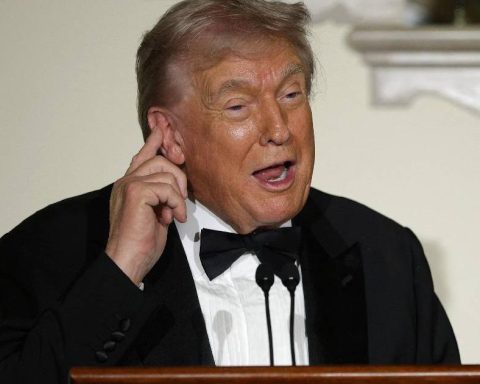For more than a century the fight for oil sparked wars, forced unexpected alliances and sparked numerous diplomatic conflicts.
Now the world’s two largest economies are fighting over another precious resource: semiconductors, the microchips that literally power our daily lives.
These tiny bits of silicon are at the heart of a $500 billion industry, expected to double by 2030. And whoever controls their supply chains – a tangled web of companies and countries that make microchips – owns the key to becoming a dominant superpower.
China wants the technology to produce the microchips, which is why the United States, the source of much of the technology, is isolating Beijing.
The two countries are clearly locked in an arms race in the Asia-Pacific region, says Chris Miller, author of Chip Wars and associate professor at Tufts University in Massachusetts, United States.
And he adds that there are more elements in that race.
“It takes place in traditional aspects such as the number of ships or missiles produced, but increasingly it also takes place in terms of the quality of artificial intelligence (AI) algorithms that can be implemented in military systems.” .
For now, the United States is winning, but the microchip war declared on China is reshaping the global economy.
Semiconductor manufacturing is complex, specialized, and deeply integrated.
An iPhone contains microchips that are designed in the United States, produced in Taiwan, Japan or South Korea, and then assembled in China. India, which is investing heavily in this industry, could play an important role in the future.
Semiconductors were invented in the United States, but over time East Asia has become their center of production, mainly because of government incentives and subsidies.
This has allowed Washington to develop business ties and strategic alliances in a region vulnerable to Russian influence during the Cold War. And these are still very useful today in the face of the increasingly present influence of China in the Asia-Pacific area.
The competition is all about making the best and most efficient microchip at scale, and the smaller the better. It’s the challenge of how many transistors, the tiny electrical switches that can turn off or let current through, fit on the tiniest piece of silicon.
“It’s what the semiconductor industry calls Moore’s law, which is essentially doubling the density of transistors over time, and that’s a very difficult goal to achieve,” says Jue Wang, a partner at consulting firm Bain. & Company in Silicon Valley, California.
“It’s what makes our phones faster, our digital photo archive bigger, our smart devices smarter over time, and our social media content more rich.”
Achieving that is not easy even for major microchip manufacturers.
In mid-2022, Samsung became the first company to start mass production of three-nanometer-scale microchips.
Something that the Taiwan Semiconductor Manufacturing Company (TSMC), the largest microchip manufacturer in the world and Apple supplier, also managed to do towards the end of that year.
To give you an idea, we are talking about finer lines than a human hair, which are between 50 and 100,000 nanometers.
These smaller “state of the art” microchips are also more powerful, which means they are incorporated into more valuable devices like supercomputers and artificial intelligence products.
And while the market for the other microchips that are part of the mundane objects of our lives – microwaves, refrigerators, or washing machines – is also lucrative, it is expected to fade in the future.
Most of the world’s microchips are made in Taiwan, giving the tiny island what its president calls a “silicon shield,” which in other words means protection from China, which continues to claim the territory as its own.
Beijing has also made microchip production a national priority and is investing aggressively in supercomputers and artificial intelligence. It is still nowhere close to becoming one of the world leaders in this area, but in the last decade it has come very close, especially, Professor Miller points out, in his abilities to design microchips.
“What you find historically is that every time the most powerful countries make advances in information technology, what they do is implement it in their intelligence and military systems,” he added.
It is this, and its reliance on Taiwan and other Asian countries to meet its demand, that is troubling the United States.
The Biden administration is trying to obstruct China’s access to microchip technology.
In October last year, Washington announced a sweeping series of controls that make it virtually impossible for companies to export microchips, the machines that make them, or programs containing US technology to China no matter where in the world they are based.
It also prohibited its citizens or residents of its country from supporting the “development or production” of microchips in certain factories in China.
This has hit the Asian giant, which is dependent on imported hardware and human talent to fuel its nascent chip industry.
“Talent is very important in this sector. If you look at the executives of Chinese semiconductor companies, many of them have US passports, studied or developed in that country and have green cards. That’s a big problem for China.” said Linghao Bao, a policy research analyst at Trivium China.
The United States, for its part, also wants to produce more microchips. With the CHIPS and Science law, some US$53,000 million are provided in grants and subsidies to companies that decide to manufacture semiconductors in the United States.
This is being taken advantage of by big companies like TSMC, which is investing in two US$40 billion worth of plants, its first outside of Taiwan.
Micron, the largest maker of memory chips in the United States essential to supercomputers, military equipment and any device that incorporates a processor, announced plans to invest about $100 billion over the next 20 years in a plant to build chips in the US. New York State.
“The law allows us to reduce the differences in production costs that exist in the United States versus those in Asia,” said Sanjay Mehrotra, CEO of Micron Technology.
“Micron will continue to invest in our plants in Asia. What is important is that there will be parity in the industry globally.”
the role of china
The US restrictions are hurting China where it really hurts.
There are reports that Apple has abandoned a deal to buy memory chips from one of China’s most successful manufacturers, Yangtze Memory Technologies Corp (YMTC), due to the restrictions.
And the experience with Huawei is likely to be repeated again, Bao warns.
The telecommunications giant went from being the second largest smartphone maker in the world behind Samsung to being practically dead.
“It was that easy for Washington to strike down a Chinese tech company and Beijing doesn’t really have a clear choice to respond to that deal,” Bao added.
“Before, the United States targeted individual companies, but this time its range of action has expanded to the entire country.”
So can China do anything? Withdrawing your products and services or imposing your own export controls may do you more harm than good, especially when your own economy is slowing sharply.
Beijing protested to the World Trade Organization (WTO), but a resolution from the body could take years.
Meanwhile, experts say, China could double down on investment to support its own microchip industry.
“We will focus on national strategic needs, rally our strengths to carry out our own scientific and technological research with the determination to win the battle in key technology sectors,” President Xi Jinping said at the Party congress. Communist in October of last year.
In the short term, the industry is facing the economic crisis generated by the war in Ukraine, high inflation and the bumpy reopening of the Chinese economy.
Due to the impact of the coronavirus pandemic, Beijing will surely move very carefully.
“There will be a lot of push and pull between American companies, Taiwanese companies, Chinese companies and every other firm from another country. It will only be where the most advanced memory and logic microchips are concerned that we will see a real effort from Washington to isolate China’s innovation networks and an effort by Beijing to build its own supply chain without the US presence,” Miller concluded.
That, he adds, could mean a dissociation of the ecosystem, one concentrated in China and another in the rest of the world.
This will have effects on the global economy and will force all parties to choose sides, with the likely risk that many will not be able to access the Chinese market.
Now you can receive notifications from BBC News World. Download the new version of our app and activate them so you don’t miss out on our best content.
















